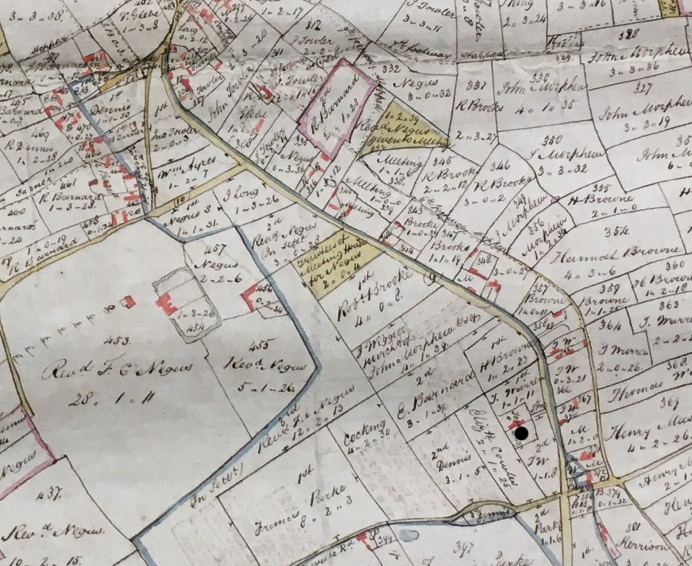1769 Dwelling House for the Poor
In 1769 a house to accommodate the poor was built upon land at the lower part of the common of Town Green. The land was given to the parish by the Lady of the Manor of Ellingham Hall, Margaretta Colman, the wife of the late Fysher Colman.
The common of Town Green included not only what we understand to be Town Green today, but also land on the western side of Long Street.

Extract from 1802 Map of Great Ellingham. Original held at Norfolk Record Office. Russell James Colman Plans. Cat. Ref. C/Ca 1/84. With kind permission of NRO
The black dot on the above extract from an 1802 map of Great Ellingham indicates the position of the ‘Town House’ built in Long Street in 1769. The blue lines indicate the boundaires of the common of Town Green.
1834 Poor Law Act
Before the introduction of the Poor Law Act of 1834, the responsibility for the poor of the village fell upon the parish itself. The cost of looking after the poor fell upon the middle and upper classes through local taxation i.e. the poor rate.
Under the 1834 Poor Law Act, parishes were grouped together into unions. Each union built a workhouse (if one did not exist already). Thereafter, the poor of a parish could only obtain help if they were prepared to leave their homes and go into the workhouse.
Great Ellingham was in the Wayland union. The Wayland Workhouse was at nearby Rocklands.
Therefore, it is no surprise to find that in 1836, the ‘Town House’ owned by the Parish was sold.
1836 Auction of Two Freehold Cottages
The Norfolk Chronicle and Norwich Gazette of Saturday September 24, 1836, include the notice of a forthcoming auction at the Crown Inn, Great Ellingham on Tuesday, 27th September, 1836. Pursuant to an order of the Poor Law Commissioners for England & Wales, the following property would be sold:
TWO FREEHOLD COTTAGES, with about one Acre of Land, belonging to the above parish [Great Ellingham], and now in the occupation of B. Long and others.
Purchaser
Local man, Edward Wilkins, purchased the cottages. Edward lived in a house on the eastern side of Long Street (later known as Fir Tree Farm), not far from the cottages. He also owned the land on either side of the Town House.
In 1816, Edward Wilkins inherited land and property (including his house) from his cousin, William Warren.
An Estates & Occupations of Great Ellingham complied around 1836-1840, suggests that following Edward Wilkins’ purchase, the property was occupied by ‘Chaplin’. However, with several Chaplin families living in Great Ellingham at that time, it is difficult to pinpoint exactly which Chaplin family lived in the house.
Sources:
1799-1842. F W Horner, Records of the Surveyors to the Commissioners for Inclosure in Parishes in Norfolk and Suffolk. Great Ellingham (Act 1799). Norfolk Record Office. Catalogue Ref: BR 90/2.
1802 Russell James Colman Plans. Norfolk Record Office. Catalogue Ref: C/Ca 1/84
24 September 1836. The Norfolk Chronicle & Norwich Gazette. Viewed via https://www.britishnewspaperarchive.co.uk